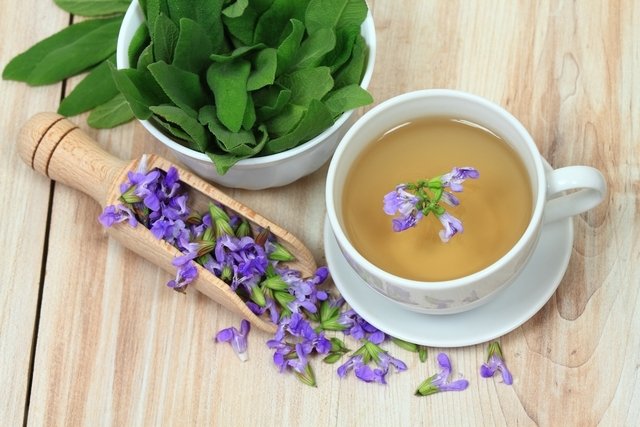Sage is a medicinal plant of the species Sage officinalisindicated to help in the treatment of heartburn, ulcers, rheumatism or diabetes, as it is rich in substances with anti-inflammatory, antioxidant and hypoglycemic properties.
The normally used parts of this medicinal plant, also known as sage, are the leaves for preparing tea, or even the aerial parts, widely used in cooking to prepare meats or sauces, due to their fragrant aroma.
Sage can be purchased at markets, fairs or natural product stores, and its medicinal use should always be carried out under the guidance of a doctor or other professional who has experience with the use of medicinal plants.

What is it for
Sage is indicated to help in the treatment of:
- Heartburn, poor digestion or stomach ulcers;
- Diarrhea or excess intestinal gas;
- Excessive sweating;
- Rheumatism or gout;
- Alzheimer’s disease;
- Inflammations in the mucosa of the mouth and pharynx;
- Skin injuries or inflammations;
- Lack of appetite;
- Bad cholesterol or high triglycerides.
Furthermore, sage can help in the treatment of diabetes, as due to its hypoglycemic and antioxidant effects, it can help lower blood sugar levels.
Sage has anti-inflammatory, antioxidant, analgesic, antimicrobial, healing, hypoglycemic, antilipidemic and memory and concentration stimulating properties, due to the phenolic compounds, flavonoids, sterols and terpenes in its composition.
Although it has health benefits, this medicinal plant does not replace medical treatment and should be used under the guidance of a doctor or herbalist.
How to make sage tea
To prepare sage tea, you must use the leaves of this plant from which the active substances of this medicinal plant are extracted.
Ingredients
- 1 tablespoon of sage leaves;
- 1 cup of water.
Preparation mode
Boil the water and add it to a cup. Place the sage leaves in the cup with boiling water and leave to rest for about 5 to 10 minutes. Strain, wait for it to cool and drink 1 cup of tea, 3 times a day
Sage tea can also be used to gargle or rinse several times a day to treat injuries in the mouth or throat.
How to use
In addition to being used to prepare tea, sage can also be used in the form of a tincture to help treat rheumatism, gout or diabetes, and the oral dosage will depend on the concentration of the solution and should be guided by the doctor. .
Additionally, sage tincture can be used in the form of mouthwash for inflammation in the mouth or throat, or skin lesions.
Another way to use sage is in cooking, to prepare meats, sauces or vegetables, for example.
Possible side effects
Sage is considered safe when used in cooking, or as a tea. However, when consumed in quantities greater than those recommended, it can cause a feeling of nausea, heat, increased heart rate and epileptic spasms.
Who shouldn’t use
Sage should not be used by people who are allergic to this medicinal plant.
Furthermore, it should also not be used during pregnancy because there is not yet enough scientific data to prove that sage is safe during pregnancy. It should also not be used during breastfeeding because it reduces milk production.
In the case of people with epilepsy, the plant should only be used under the guidance of a doctor or herbalist, as some studies indicate that the plant can stimulate the development of epileptic seizures.
Bibliography
- GHORBANI, A.; ESMAEILIZADEH, M. Pharmacological properties of Salvia officinalis and its components. J Tradit Complement Med. 7. 4; 433-440, 2017
- BEHRADMANESH, S.; et al. Effect of Salvia officinalis on diabetic patients. J Renal Inj Prev. 2. 2; 51–54, 2013
- BAHR, Tyler A. et al.. The Effects of Various Essential Oils on Epilepsy and Acute Seizure: A Systematic Review. Evidence-based Complementary and Alternative Medicine. Vol.2019. 2019
- EPILEPSY SOCIETY. Complementary therapies. Disponível em: <https://epilepsysociety.org.uk/living-epilepsy/wellbeing/complementary-therapies>. Acesso em 15 dez 2020
- GRUNWALD, JORG; JANICKE, CHRISTOF. The green pharmacy. Spain: Editora Everest, 2009. 346-347.
- FINTELMANN, Volker.; WEISS, Rudolf F. Phytotherapy manual. 11th edition. Rio de Janeiro: Guanabara Koogan, 2010. 316.
- CURTIS, Susan et al. The medicinal herb recipe book. São Paulo: Dorling Kindersley, 2011. 84.

Sign up for our newsletter and stay up to date with exclusive news
that can transform your routine!
Warning: Undefined array key "title" in /home/storelat/public_html/wp-content/plugins/link-whisper-premium/templates/frontend/related-posts.php on line 12
Warning: Undefined array key "title_tag" in /home/storelat/public_html/wp-content/plugins/link-whisper-premium/templates/frontend/related-posts.php on line 13


